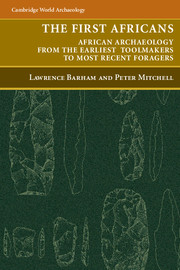Book contents
- Frontmatter
- Contents
- List of Figures and Tables
- Acknowledgements
- THE FIRST AFRICANS
- 1 Introducing the African Record
- 2 Frameworks in Space and Time
- 3 First Tool-Users and -Makers
- 4 Early Pleistocene Technologies and Societies
- 5 Mid-Pleistocene Foragers
- 6 Transitions and Origins
- 7 The Big Dry: The Archaeology of Marine Isotope Stages 4–2
- 8 Transitions: From the Pleistocene into the Holocene
- 9 Hunting, Gathering, Intensifying: The Mid-Holocene Record
- 10 Foragers in a World of Farmers
- 11 The Future of the First Africans' Past
- Notes
- Glossary
- References
- Index
8 - Transitions: From the Pleistocene into the Holocene
Published online by Cambridge University Press: 05 June 2012
- Frontmatter
- Contents
- List of Figures and Tables
- Acknowledgements
- THE FIRST AFRICANS
- 1 Introducing the African Record
- 2 Frameworks in Space and Time
- 3 First Tool-Users and -Makers
- 4 Early Pleistocene Technologies and Societies
- 5 Mid-Pleistocene Foragers
- 6 Transitions and Origins
- 7 The Big Dry: The Archaeology of Marine Isotope Stages 4–2
- 8 Transitions: From the Pleistocene into the Holocene
- 9 Hunting, Gathering, Intensifying: The Mid-Holocene Record
- 10 Foragers in a World of Farmers
- 11 The Future of the First Africans' Past
- Notes
- Glossary
- References
- Index
Summary
The Big Dry, the theme of Chapter 7, came to a temporary end around 10 kya. Comparative studies of cultural change across the Pleistocene/Holocene boundary identify several themes (Straus et al. 1996). Set against major shifts in climate and ecology, these include the (re)colonisation of previously uninhabited landmasses, the migration of human populations, the innovation of novel technologies, and the development of new subsistence strategies. Africa was not unaffected. This chapter collates and assesses the evidence for these themes on a continental scale and in a generally south-to-north direction. The archaeological record is, of course, more than a simple pattern of cultural response to environmental stimulus, and better-refined chronological controls and more plentiful archaeological observations render the Pleistocene/Holocene transition more suitable than earlier periods for developing alternative perspectives that take account of the social histories and cultural heritages of human groups. This chapter thus documents a diversity of transitions – cultural and environmental – between 15 and 8 kya, while it also illustrates the difficulty of generalising to Africa the standard narrative of agricultural origins generated from the Near East.
ENVIRONMENTAL BACKGROUND
At the Last Glacial Maximum (LGM) Africa's climate was cooler and generally more arid than today. Consequences included the expansion of deserts and grasslands and the fragmentation, or at least substantial modification, of the tropical rainforests. The transition from this situation to that characterising the Holocene was far from straightforward. ‘Complex’ and ‘oscillatory’ better describe both the global and the African signatures of climate change.
- Type
- Chapter
- Information
- The First AfricansAfrican Archaeology from the Earliest Toolmakers to Most Recent Foragers, pp. 308 - 355Publisher: Cambridge University PressPrint publication year: 2008



